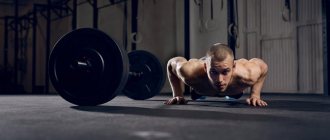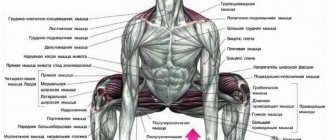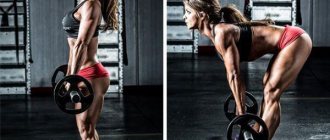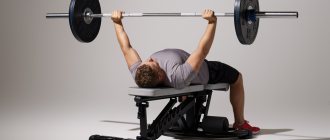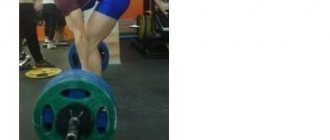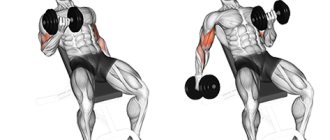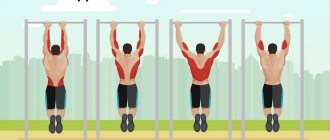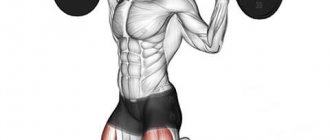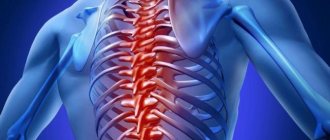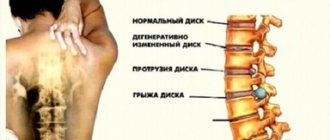Share:
What you need
- Barbell
- Platform
Deadlift is one of the most common exercises among all sports disciplines. It is actively used in powerlifting and crossfit, and is also a good auxiliary exercise for increasing the overall strength and power of an athlete, so mixed martial arts fighters, fans of boxing and oriental martial arts also do not bypass it, thereby gaining crazy strength and increasing their overall athletic potential. Today we will tell you how to do deadlifts correctly, as well as the main types, techniques, standards and alternatives to this exercise.
What is a deadlift?
What kind of exercise is the deadlift? In short, it is lifting a barbell (or other weight) from the floor, performed by working the muscles of the legs and back. This exercise is excellent for gaining muscle mass and increasing strength, since here we can work with serious weights, while using almost all muscle groups of our body. The deadlift is rightfully considered a classic basic exercise, which no athlete can exclude from his program.
Beginners, as well as experienced athletes, are strongly recommended to begin deadlift training with a thorough warm-up and stretching. The movement must be powerful and synchronous, each muscle must be involved in the work exactly when necessary, and it is unlikely that it will be possible to perform a deadlift technically correctly without properly preparing our muscles and joint-ligamentous apparatus for heavy power work.
There are 3 main types of deadlifts: classic, sumo and Romanian. Each of them is complemented by a different variation of weights (barbell, kettlebell, dumbbells, Smith machine, trap bar, etc.) We will talk about each type separately.
The difference between them lies in the position of the arms and legs, due to which the load falls more on the back or legs. There are also several additional types of this exercise that are of no less interest to us, for example:
- deadlift on straight legs (Romanian deadlift);
- deadlift in the Smith machine;
- deadlift with trap bar;
- deadlift with dumbbells.
We will look at each of these types in more detail in this article.
conclusions
As you can see, the second training program is quite vague. We get the impression that Magnusson has a good understanding of what works for him, but doesn't follow a set routine from a specific strength coach. The results speak for themselves.
Magnusson and his brother were genetically designed to lift very heavy weights. If you are going to follow his program, you will have to edit it to suit your needs. Even if this technique does not help you lift 500 kg, we guarantee that you will be able to lift much more weight than usual.
Deadlift Equipment
A conversation about deadlift would be incomplete without mentioning the current records in this movement. Deadlifts can be performed without equipment or with equipment. The question arises: what can be considered equipment? Overalls? Straps? Or even a belt? We share the most conservative position on this issue, namely: equipment is what increases your results, so straps, overalls and knee bandages can safely be classified as equipment division.
The belt is a slightly different story. Of course, an athletic belt helps lift slightly more weight when performing deadlifts, but its primary function is to protect you from the occurrence of an umbilical hernia or lower back injuries, so its use is acceptable and often even necessary in raw powerlifting, and this does not contradict the rules of the federations. There are no more unique people like Konstantin Konstantinov, who are able to lift more than 400 kg without a belt, in the whole world, so it is better to take care of your overall health in advance and not neglect the use of a belt. Portal cross.expert – for safe sports.
How many repetitions to perform in one approach?
The number of repetitions in deadlift training should be minimal. Apparently, 4 repetitions per set is enough not only in training, but also in warm-up!
Significantly increase the weight between sets to quickly reach the barbell weight needed for the main work. Try to avoid two or more repetitions when approaching maximum and submaximal weights, because this requires a significant expenditure of mental energy, which you will need for competitive approaches. A typical workout for a lifter hoping to lift 270 kg in competition might look like this:
- 100 x 4
- 140 x 4
- 180 x 4
- 210 x 4
- 230 /2 x 4
Deadlift records
One way or another, the current absolute record in deadlift belongs to Icelander Benedikt Magnusson (weight category over 140 kg). He conquered 460 kg. There are two more equally impressive records, but they were performed using straps and overalls. However, this does not detract from their importance:
- Briton Eddie Hall conquered 500 kg (weight category over 140 kg), watch the epic video of this event below;
- Russian Yuri Belkin won 450 kg (ATTENTION, weight category up to 110 kg).
Which of these is more significant for the development of sports as a whole and setting the right example for novice athletes, decide for yourself. My opinion is the following: Belkin’s result is simply space. We wish the athlete to set new world records and avoid injuries.
About the uselessness of wrist straps for traction and the importance of grip development.
If you want to increase the lift of the barbell in the deadlift, and do not want to have problems with holding the barbell in your hands, then never use wrist straps for deadlifting. If your arms don’t hold, then no back will help you take more weight. And training without straps only develops the correct grip for deadlifts.
And this requires practically no additional exercises; they can even interfere, since overloading the forearms weakens the grip. And when reaching from stands, you will hold more weight than the maximum. So don’t put unnecessary strain on your back and forearm, save your strength for the main movement.
And lastly, there should be rest between approaches: 1-3 minutes in the warm-up part of the system, and 5-10 minutes in the main part. There is no need to rush, but there is also no need to delay it too much.
Types and technique of execution
Next we will dwell in detail on the types of deadlifts, of which there are much more than an inexperienced athlete might think. Let's start, of course, with the classic version.
Classic deadlift
The classic version of the deadlift is perhaps the most common in crossfit, extreme strength training and powerlifting. There is no exact information about what sports discipline it originated in, but most likely it was weightlifting - the first part of the push represents precisely this movement.
So, how to do deadlifts correctly step by step (execution technique):
- With a classic deadlift, the athlete grabs the bar shoulder-width apart, his legs are slightly narrower, and his feet are parallel to each other.
- The bar of the barbell is pushed as close as possible to the shins, so it is recommended to use gaiters when performing deadlifts.
- The shoulder blades and shoulders are pulled back slightly.
- The movement begins with the movement of the legs - the bar must be “torn off” with the force of the quadriceps and buttocks. When the bar has passed 20-30% of the amplitude, the athlete should begin moving with his back, fully straighten at the waist and lock in the final position.
A short video with the deadlift technique:
Most of the load in the classic deadlift falls on the back muscles (namely, the spinal extensors and trapezius muscles), so this option is recommended for athletes whose back muscles predominate over the leg muscles. There are also a number of anatomical features of the body’s structure (for example, long arms or a short torso), in which it is worth performing classic deadlifts.
The main mistake beginners make here is rounding their back when lifting (hump row). By doing this, you risk getting a serious back injury and forgetting about athletic longevity.
Pay careful attention to practicing the correct exercise technique so you can get the most out of this movement.
Detailed video about the correct execution of the classic deadlift, analysis of typical mistakes of beginners:
Sumo deadlift
With a sumo deadlift, the load shifts more to the quadriceps and hip adductors. The latissimus dorsi, spinal extensors and abdominal muscles bear more of a static load, since extension in the lumbar region is much less than in the classic version.
When doing sumo deadlifts, the athlete grabs the bar slightly narrower than shoulder level, and, on the contrary, places his legs wider. How wide depends on the level of stretch. It is clear that the wider the legs are, the shorter the amplitude will be, and, therefore, the higher the result will be, however, if you do not have sufficient stretching, if you place your legs too wide, you risk getting a sprain or tear of the adductor muscles. Therefore, it is recommended to start with a medium foot position (slightly wider than shoulder width) and gradually increase it, while not forgetting to pay special attention to stretching.
The movement in the lower back during the sumo deadlift is minimal; we do not need to “bend” with the barbell, as with the classic version. We need to lift it with maximum effort from the leg muscles, without rounding the back or leaning forward.
The most common mistake beginners make when performing sumo deadlifts is moving too much in the back. At the lowest point, they lean over the barbell and tear it off with the simultaneous effort of their back and legs. This is fundamentally wrong: when doing sumo deadlifts, we engage our backs only in the upper part of the amplitude (approximately the last 20% of the movement), working with serious weights. If it is more convenient for you to transfer part of the load to the lower back, it is better to perform deadlifts in the classic version, pay sufficient attention to developing the technique, and personal records will not take long to arrive.
The sumo deadlift is more suitable for athletes with well-developed legs and buttocks. Great for athletes with long torsos and short arms.
Deadlift on straight legs (Romanian deadlift)
The Romanian deadlift has nothing in common with powerlifting, but is an excellent isolation exercise for developing the glutes and hamstrings. The movement is performed on straight legs and with a fixed back by moving the buttocks back. Working in such an amplitude, the biceps of the thigh stretches perfectly in the positive phase of the movement and contracts in the negative phase.
In this exercise, the neuromuscular connection is primary, and not the weight being lifted, so I do not recommend performing straight-legged deadlifts with heavy weights unless you feel an accentuated load on the desired muscle groups. In addition, when working with heavy weights, there is a risk of damaging the hamstrings, which stretch as the pelvis moves back. This can stop your progress in the squat and deadlift as it will take at least a few weeks to recover.
Smith machine deadlift
This is not the most common exercise, however, it has obvious advantages. The Smith machine gives us the opportunity to work along a trajectory specified by the joints, so it is easier for us to focus on the biomechanics of movement and “catch” the contraction of the desired muscles.
In addition, in Smith it is very convenient to set the limiters to the desired level and work due to this in a shortened amplitude (performing some kind of traction from the plinths). A shorter range of motion allows us to get used to working with heavier weights, improves grip strength, and prepares a good foundation for increasing strength in the deadlift and other basic exercises.
Deadlift with trap bar
If your gym is equipped with a trap bar, rejoice! In Russia this is very rare, but in vain, because this bar allows us to work in a slightly different amplitude and increase our strength indicators. The trap bar has the shape of a diamond, inside of which there are handles for gripping. The palms are parallel to each other, and the handles themselves are at the level of the body, making it much easier to keep your back straight throughout the lift, which many people lack when performing classic deadlifts.
Here is a detailed description of the technique for performing deadlifts with a trap bar.
Deadlift with dumbbells
An obvious advantage in working with dumbbells is a longer amplitude, since the dumbbell bar will be located below the barbell bar. Therefore, deadlifts with dumbbells have a place in the training process of a CrossFit athlete, since it is convenient to combine them with dumbbell push-ups or thrusters.
In addition to the semblance of the classic deadlift, there is an exercise called “plie squats”, which is popular among many girls who are interested in fitness. The movement is similar to a sumo-style deadlift, however we do not place dumbbells on the floor and work without stopping in the top position in a shortened amplitude, keeping the hip adductors in constant tension. The back should be kept straight throughout the entire exercise, the weight of the weight is selected individually, but it should be borne in mind that in such isolated exercises there is practically no point in working less than 10-15 repetitions. Here we work on target muscle groups, and do not set strength records.
10 WEEK TRAINING CYCLE
| WEEK 1 | Deadlift: warm up, then 80% 3x3 6-inch block rows: 85% 3x3 3-4 additional exercises for weak points |
| WEEK 2 | Deadlift: warm up, then 85% 3x3 4-inch bar rows: 90% 2x2 3-4 additional exercises for weak points |
| WEEK 3 (unloading) | Deadlift: warm up to 60%, 6 singles for speed and technique 3-4 additional exercises for weak points |
| WEEK 4 | Deadlift: warm up, then work in doubles to the last planned warm-up weight (85-87%) Deadlift with 6-inch blocks: to a record 3RM 3-4 additional exercises for weak points |
| WEEK 5 | Deadlift: warm up, then work in doubles to the target starting weight (90-92%) Deadlift with 4-inch blocks: to a record 3RM 3-4 additional exercises for weak points |
| WEEK 6 (unloading) | Deadlift: warm up to 60%, 6 singles for speed and technique 3 easy additional exercises for weak points |
| WEEK 7 | Deadlift: Warm up, then work in singles to target starting weight and target 2nd attempt 6″ block rows: 3rd attempt, 1-2 reps 2 easy additional exercises for weak areas |
| WEEK 8 (must be 10 days before competition) | Deadlift: work until the expected 1st attempt in singles. Focus on Speed and Technique 32 Easy Complementary Exercises for Weaknesses |
| WEEK 9 (unloading) | Do some light additional exercises on weak areas to get some blood flowing for recovery. |
| WEEK 10 | COMPETITIONS. TIME FOR RECORDS! |
More powerlifting programs here.
Deadlift Standards
Separate deadlift competitions are held under the auspices of all powerlifting federations operating in Russia (FPR, WPC/AWPC, ASM “Vityaz”, etc.). At the same time, there is no distinction as to what style the athlete should pull in: sumo or classic. For many athletes, this moment causes indignation, some demand the introduction of a separate division for sumo deadlifting, some demand that sumo deadlifting be completely banned, and existing records invalidated, or the creation of a separate federation where everyone will lift in sumo... These statements are heard, in my opinion, it is simply absurd. The rules of the federation do not regulate any type of deadlift as the only correct one, and each athlete has the right to choose the style in which he is able to show the greatest results, at his own discretion.
Below are the standards for deadlifts for men, approved by probably the most popular federation among amateur athletes - AWPC (doping control division). The standards of this federation for deadlift are quite democratic, so it will not be too difficult for any more or less prepared athlete to prepare for some regional competitions and first complete the first adult category. And then - more. Therefore, if you have already achieved certain results in the deadlift, try to confirm them in competitions. An adrenaline rush and an unforgettable experience are guaranteed.
Rating standards for men's deadlift without equipment (AWPC):
| Weight category | Elite | MSMK | MS | KMS | I category | II category | III category | I junior | II junior |
| 52 | 197,5 | 175 | 152,5 | 132,5 | 115 | 105 | 90 | 75 | 60 |
| 56 | 212,5 | 187,5 | 162,5 | 142,5 | 125 | 115 | 97,5 | 82,5 | 65 |
| 60 | 225 | 200 | 172,5 | 150 | 132,5 | 120 | 105 | 87,5 | 70 |
| 67,5 | 247,5 | 217,5 | 190 | 165 | 145 | 132,5 | 112,5 | 95 | 75 |
| 75 | 265 | 232,5 | 202,5 | 177,5 | 155 | 142,5 | 122,5 | 102,5 | 80 |
| 82,5 | 277,5 | 245 | 215 | 185 | 162,5 | 150 | 127,5 | 107,5 | 85 |
| 90 | 290 | 255 | 222,5 | 195 | 170 | 155 | 132,5 | 112,5 | 90 |
| 100 | 302,5 | 267,5 | 232,5 | 202,5 | 177,5 | 162,5 | 140 | 115 | 92,5 |
| 110 | 312,5 | 275 | 240 | 207,5 | 182,5 | 167,5 | 145 | 120 | 95 |
| 125 | 322,5 | 285 | 247,5 | 215 | 190 | 175 | 150 | 125 | 100 |
| 140 | 332,5 | 292,5 | 255 | 222,5 | 192,5 | 177,2 | 152,5 | 127,5 | 102,5 |
| 140+ | 337,5 | 300 | 260 | 225 | 197,5 | 182,2 | 155 | 130 | 105 |
You can download and print the table if necessary using the link.
For women:
| Weight category | Elite | MSMK | MS | KMS | I category | II category | III category | I junior | II junior |
| 44 | 127,5 | 115 | 100 | 85 | 75 | 70 | 60 | 50 | 40 |
| 48 | 140 | 122,5 | 107,5 | 92,5 | 82,5 | 75 | 65 | 52,5 | 42,5 |
| 52 | 150 | 132,5 | 115 | 100 | 87,5 | 80 | 70 | 57,5 | 45 |
| 56 | 157,5 | 140 | 122,5 | 105 | 92,5 | 85 | 72,5 | 60 | 47,5 |
| 60 | 165 | 147,5 | 127,5 | 110 | 97,5 | 90 | 77,5 | 62,5 | 50 |
| 67,5 | 177,5 | 157,5 | 135 | 117,5 | 102,5 | 95 | 82,5 | 67,5 | 55 |
| 75 | 185 | 165 | 142,5 | 125 | 110 | 100 | 85 | 72,5 | 57,5 |
| 82,5 | 192,5 | 170 | 150 | 130 | 112,5 | 105 | 90 | 75 | 60 |
| 90 | 200 | 177,5 | 152,5 | 132,5 | 117,5 | 107,5 | 92,5 | 77,5 | 62,5 |
| 90+ | 202,5 | 180 | 155 | 135 | 120 | 110 | 95 | 80 | 65 |
You can download and print the table if necessary using the link.
Errors
Everyone has heard about rounding the back and walking knees more than once and there is no discovery in these errors. Bone Wide brings to your attention mistakes that you most likely never paid attention to!
- Converting Deadlifts to Squats
Deadlifts are not squats with a barbell in your hands, no matter what indoor bodybuilders say. If we compare the deadlift with squats, then it is more like half squats rather than full-amplitude squats.
You need to start the deadlift in a half-squat - yes, individual characteristics leave an imprint, but you should not lift the barbell from a very deep squat.
When you start too low, the bar is too far away from your torso, which is not good for your lower back and puts your leverage in a weaker position.
- Lean back
Those who are overly agile often lean back during deadlifts to demonstrate complete control over the working weight. Some do this completely unconsciously, but this fact does not change the matter. There is no need for this.
Even according to the rules of powerlifting competitions, you need to lock your knee and hip joints while standing absolutely vertical. When a person leans back, guess what happens to their knees?
They bend slightly, which weakens your stability, and arching in the lower back during deadlifts opens the door to spinal diseases, such as a herniated disc. For safety and effectiveness, deadlift until your joints are locked and your torso is upright—buttocks contracted, hips straight—without leaning too far back.
- Inappropriate shoes
Leave your Airmaxes in the locker room, just like your running shoes! As a rule, such shoes have shock-absorbing soles. increased instability during heavy deadlifts . If you currently use thick-soled running shoes, changing your shoes—or simply taking them off for a deadlift—will instantly increase the amount of weight you can lift.
It is best to perform deadlifts in sneakers with flat and hard soles . This will add stability and evenly distribute the load on the foot. Read more about choosing sneakers in this article .
No need to go barefoot either!
- Excessive leaning over the barbell
Instead of squatting too deeply, which was our first point, here we are dealing with leaning over the bar and barely perceptible bending of the knees.
This technique is close to the Romanian deadlift , which is an exercise for the buttocks and upper hamstrings.
This is a single-joint movement in the hip joints and should not be confused with a deadlift. You need to lean into a half squat, not just bend over .
Alternative Deadlift Exercises
What can replace deadlifts? I’ll say right away that the following information is intended for those athletes who cannot perform deadlifts due to medical contraindications, but want to work target muscle groups using other exercises.
For everyone else, the answer is: NOTHING.
The deadlift is a multi-joint exercise that uses almost all the muscles in our body. And the effect it has on our strength and muscle mass can hardly be replaced by hyperextensions, barbell bends, or exercises for the hip adductors. Therefore, if you cannot perform deadlifts because axial load on the spine is contraindicated for you, include the following exercises in your training process:
- Pull-ups on the bar – probably the best exercise in the world for gaining back muscle mass and creating a V-shaped silhouette. It is important to try to carry out the movement by contracting the latissimus muscles, bringing and spreading the shoulder blades, while minimally including the forearms and biceps. This way you will get maximum efficiency from this exercise. Perform other lat exercises where the axial load is minimal (wide-grip vertical pull-down, close-grip horizontal pull-down, overhead pullover, hummer row, etc.) in order to put more stress on the muscles and create the preconditions for growth of muscle mass.
© Makatserchyk — stock.adobe.com
- Hyperextension – an exercise that perfectly develops the main muscle group that works during the classic deadlift – the spinal extensors. It is noteworthy in that the axial load in it is practically zero, therefore it is strongly recommended to be performed not only as an alternative to the deadlift, but also as an addition to it, and as a general strengthening preventive exercise, and as an exercise aimed at rehabilitating an injured lower back.
© Makatserchyk — stock.adobe.com
- Reverse hyperextensions – a type of hyperextension where the athlete contracts the target muscle group by lifting the legs rather than the body. The load here is more directed at the lower part of the spinal extensors; the sacrum area receives the maximum blood flow.
- Advances and flyes while sitting in the simulator – exercises with which you can separately load the adductor muscles of the thigh and buttocks without axial load on the spine. Therefore, if the sumo deadlift is contraindicated for you, you may well include these two exercises in your arsenal.
© Makatserchyk — stock.adobe.com
Sumo or classic: the difference in technique
What is the difference between these two types of traction?
- Well, the answer is obvious: the position of the legs . Depending on the width of your legs, the height of the barbell changes. The wider the legs are spread, the lower the lifting height of the projectile. Those. By placing your feet wider, you simply make the task a little easier for yourself and reduce your range of motion.
- Typically, the classic deadlift is chosen by people with shorter legs and a longer torso. Still, the sumo style requires a certain flexibility and mobility in the hip and knee joints.
- The sumo deadlift engages all of the hip adductors more fully. The classic technique loads the back .
- Classic requires parallel placement of the feet. Sometimes trainers advise turning them slightly to the sides. When doing sumo deadlifts, your goal is to rotate your feet 45 degrees outward.
Both deadlift variations are equally good. If you are in doubt about the choice, experiment with both options. Only then will you be able to figure out what is more convenient for you to do. The sumo deadlift has its pros and cons, just like the classic one, so the choice between them is a purely individual matter and depends on your personal comfort.
Sumo deadlifts are usually more popular among women because... in this position, more load is given to the gluteal muscles. However, remember that while hip extension exercises like these do engage the glutes, they don't engage them fully—during a deadlift, the glutes are activated by 52%.
How to improve your deadlift strength?
Your performance in a deadlift, whether classic or sumo, depends on two aspects:
- the acceleration you give to the barbell;
- maintaining proper technique on maximum weights
Boom acceleration
The greater the acceleration you set when breaking the bar, the easier it will be for you to complete the movement. Therefore, it is necessary to pay special attention to the explosive strength of the legs and back and you should include the following exercises in your training process that will help you make deadlifts more explosive and faster:
- Squats with a pause at the bottom;
- Jumping on a box;
- Standing up with a barbell from a squat position;
- Squats with a barbell on a bench;
- Snatch pull-ups.
- Deadlift paused at knee level.
Correct technique
As for the correct technique, it is purely a matter of time and experience. It is necessary to separately practice deadlifts in full, shortened and extended amplitudes.
Working in a shortened amplitude (pull from the plinths) , we can perform the exercise with a large weight, shifting the load on the entire array of back muscles. In addition, we develop grip strength and psychologically get used to maximum weights.
When working in an extended amplitude (pull from the pit) , we work with a slightly lighter weight, but we perform the movement, emphasizing the load in the quadriceps. This will inexorably lead to an increase in strength indicators in the deadlift to full amplitude, since deadlifting from the pit, of course, will be more difficult both physically and psychologically.
In addition, there are several other conditions for good traction.
The first of these is stretching. This is especially important for those athletes who perform sumo-style deadlifts. It is necessary to pay special attention to the fascia of the adductor muscles of the thigh and quadriceps - they should be elastic and mobile, perform the variations of the splits that are most convenient for your structure. This way you will protect yourself from possible injuries and will be able to work at an optimal amplitude without experiencing discomfort or pain in the muscles and tendons.
Don’t forget about stretching the torso, perform various exercises aimed at stretching the lats, chest, lower back or abdominals, from different angles, not a single muscle in your body should be “wooden”, then the deadlift will become comfortable and absolutely natural for you from the point of view of anatomy and biomechanics of movement.
Equally important is isolated work on the target muscle groups working during deadlifting. For example, you should perform pull-ups, bent-over barbell or dumbbell rows, hyperextensions, and boat lifts to keep your back muscles ready for strength work. Don't forget about our "foundation". Additionally, strengthen your leg muscles by doing barbell squats, leg presses, seated extensions and other exercises for the quadriceps and hamstrings.
Recipes for healthy eating
Eggs in dough, baked in the oven
- 11.8 g Protein
- 9.8 g Fat
- 0.7 g Carbohydrates
- 141.3 kcal
30 min.
- #dietary
- #breakfast
- #baking
- #flour
- #low calorie
- #dinner
- #vegetable oil
- #sour cream
- #dinner
- #egg
Other recipes
Interest
It should be emphasized that the indicated percentages are designed for an average lifter. If a lifter is at a higher level, then he should start with a lower percentage because he will need more time to prepare for heavy weights. I believe that intermediates (if they've trained with a good program in the off-season) can jump right into higher percentages because the weights aren't as heavy and don't tax them as much.
The heaviest lifts (in the 90% range) are performed with partial range of motion.
When determining your numbers, start from your best result in competitions or from your net lift in the gym. Just don't pick up the weight that you lifted clumsily, otherwise it will be the path to three red lights.
Principle of progression
Of course, in order to increase traction performance, you need to constantly increase weight. Make it a rule: add 5 kg to the barbell twice a month. If adding is easy, then add 5 kg 4 times a month. Get to your maximum (when it will be almost impossible to add), and still continue to add, just less often.
You can only progress when you constantly and systematically move towards it. Always try to pull out more, but first read the next point.
Increase in working weight
Quite often, the problem of how to increase the classic deadlift arises in people with “problematic” physiques. For example, someone has too short arms and fingers, which makes it difficult to hold the projectile at the top and bottom points. In addition, the bar constantly rests on the hips, interfering with proper technique. All this leads most people to despair, as they simply stop seeing the point in further training due to the lack of the desired result. But instead of despondency, experts strongly recommend that they pull themselves together and still try to increase their deadlift. How to do this is not an easy question. But it is quite possible to find an accessible answer to it.
To achieve the desired result, it will be enough to just use a few techniques. They are truly effective and suitable for every person, regardless of gender, age and physical abilities.
Duration
When discussing the topic of how to increase your deadlift as a natural, professionals focus on developing maximum strength through increasing the timing of the deadlift and range of motion. By performing the exercise with pauses, you can achieve good success in a short time. There is nothing complicated here, since you just need to stop at certain points and then continue moving. Pauses should be no more than three seconds, and their total number per repetition should not exceed two. The athlete must determine the specific levels where he needs to stop on his own - these are points that need to be worked on additionally.
Pump your legs separately
The same squats on one leg, Bulgarian squats, lunges, scissor squats - in general, all exercises that pump the legs separately will definitely have a positive effect on the results of the deadlift. The fact is that when performing exercises on one leg, those muscles are pumped that do not work when performing exercises on two legs. Therefore, sometimes you need to do exercises on one leg.
